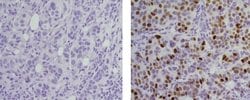Learn More
Invitrogen™ Progesterone Receptor Monoclonal Antibody (KMC912), Biotin, eBioscience™
Mouse Monoclonal Antibody
Supplier: Invitrogen™ 13976482

Description
Description: This KMC912 monoclonal antibody reacts with human progesterone receptor (PgR, PR), a member of a superfamily of nuclear receptors that are ligand-dependent transcriptional regulators. The human PgR exists in alpha and beta forms, 94 kDa and 120 kDa respectively. In most human cells, the alpha and beta forms are expressed at similar levels and predominately form heterodimers. Progestin binding to PgR causes a conformational change, allowing dissociation of bound chaperone proteins and subsequent dimerization with either PgRa or PgRb. Following activation, dimerized PgR can directly bind to DNA through progestin response elements (PRE) leading to chromatin remodeling and subsequent downregulation or transcription of the target gene.The PgR plays a key role in controlling gene expression in breast, uterine, brain, and cardiovascular tissue during development. The presence of the PgR in breast tissue is indicative of improved survival and a better response to endocrine therapy. In breast and endometrial cancer progression, a predominance of either the alpha or beta form occurs, suggesting disregulation in the PgRa:PgRb ratio is an early event in cancer. In cases of ductal carcinoma in situ and invasive ductal carcinoma, there is predominance of the alpha form while in uterine cancer a loss of either form is common. Applications Reported: This KMC912 antibody has been reported for use in immunohistochemical staining of formalin-fixed paraffin embedded tissue sectio...
The progesterone receptor (PR) is a member of the steroid family of nuclear receptors. The PR mediates the physiological effects of progesterone, which plays a central role in reproductive events associated with the establishment and maintenance of pregnancy. PR is found as a 94 kDa protein (Form A) or a 120 kDa protein (Form B) due to the use of alternative translation initiation sites. PR-B is the transcriptionally active form and is responsible for activating genes for the maintenance of the endometrium, maintenance of pregnancy, and inhibition of ovulation. PR-A is identical to PR-B except for a 165 amino acid deletion at the N-terminus. This deletion exposes a 140 amino acid inhibitory domain (ID) that acts as a repressor of steroid hormone transcriptional activity. In its inactive state, PgR forms a multiprotein complex which includes heat shock proteins and immunophins. Upon binding of progesterone hormone to its receptor, there is a conformational change that allows dimerization and binding of the receptor to progesterone response elements (PRE) sequences, resulting in activated transcription. A Null mutation in the PGR gene leads to pleiotrophic reproductive abnormalities.
Specifications
| Progesterone Receptor | |
| Monoclonal | |
| 0.5 mg/mL | |
| PBS with 0.09% sodium azide; pH 7.2 | |
| P06401 | |
| PGR | |
| Affinity chromatography | |
| RUO | |
| 5241 | |
| 4°C, store in dark, DO NOT FREEZE! | |
| Liquid |
| Immunohistochemistry (Paraffin), Immunocytochemistry | |
| KMC912 | |
| Biotin | |
| PGR | |
| 9930019P03Rik; BB114106; ENSMUSG00000074510; LOW QUALITY PROTEIN: progesterone receptor; NR3C3; Nuclear receptor subfamily 3 group C member 3; p4 receptor; PGR; pot. alt. progesterone receptor; putative; PR; PR-A; PR-B; Progesterone receptor; progesterone receptor A; progesterone-receptor; putative form B; steroid hormone receptor; testicular progesterone receptor; unnamed protein product | |
| Mouse | |
| 100 μg | |
| Primary | |
| Human | |
| Antibody | |
| IgG1 κ |
The Fisher Scientific Encompass Program offers items which are not part of our distribution portfolio. These products typically do not have pictures or detailed descriptions. However, we are committed to improving your shopping experience. Please use the form below to provide feedback related to the content on this product.
